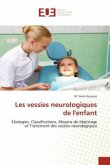Neurological bladders in children include all vesico-sphincter dysfunctions due to congenital anomalies of the nerve pathways (lumbosacral dysraphism, sacral agenesis, diastematomyelia, etc.), which are the most frequent (90%). Acquired lesions (traumatic, degenerative or tumoral) account for the remainder (10%).The consequences of these neurological bladders are twofold: urinary incontinence, a social consequence, permanent discomfort and a handicap affecting social integration, all the more serious as it is often combined with motor difficulties of neurological origin. Even more serious is the more or less rapid deterioration of the urinary tract, a vital consequence that can lead to end-stage renal failure. These two complications constitute the stumbling blocks in the therapeutic approach to neurovessel disease, with a double dilemma: attempting to improve continence by reinforcing the obstacle to outflow runs the risk of aggravating the deterioration of the upper urinary tract, while improving emptying to protect the kidneys by reducing the infra-vesical obstacle exposes the patient to the risk of perpetuating incontinence.
Bitte wählen Sie Ihr Anliegen aus.
Rechnungen
Retourenschein anfordern
Bestellstatus
Storno








